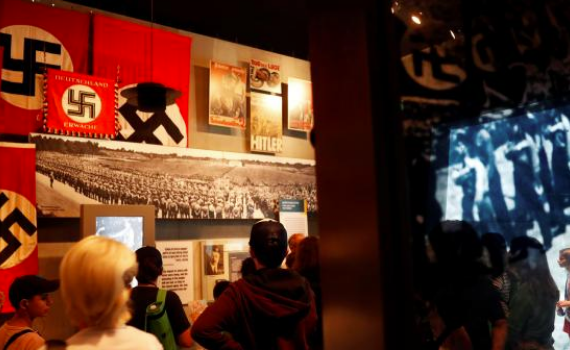
7D News
By Gary Potgieter
May 6, 2019

Anti-semitic crimes are on the rise in the United States, with the most violent form of this particular brand of hate resulting in two shootings at US synagogues.
The first shooting took place in Pittsburgh in October 2018. Eleven people were killed and six wounded. The alleged shooter, Robert Bowers, is believed to have far-right views, with some witnesses claiming he shouted “All Jews must die” before opening fire.
The second synagogue shooting took place in San Diego in April 2019. One elderly woman was killed and three others wounded in the attack. Among the wounded was Rabbi Yisroel Goldstein, who was shot in his hands. The alleged shooter was 19-year-old John Earnest, who is also believed to have espoused far-right beliefs. In fact, there is reasonable suspicion that he published a manifesto on a white supremacist group detailing his alleged crimes and his motivation.
On the surface, these two incidents may not seem to have the same impact as the Easter bombings in Sri Lanka or the double mosque shootings in New Zealand. To be fair, far fewer people died in the synagogue shootings when compared to the Sri Lanka bombings or the New Zealand shootings. But this should in no way be conflated to mean it is less important.
What the shootings show is the culmination of a marked rise in anti-semitic feelings within the United States. This rise has been noted as far back as 2017, when the Anti-Defamation League (ADL) identified a 60% rise in anti-semitic incidents in the US between 2016 and 2017. Two years later and these increases are now manifesting in mass shootings.
Make no mistake, there can be no hierarchy when it comes to murder – murder is murder, it should make no difference who is doing the killing. The only thing that should matter is the universal condemnation of the act.
But there is something uniquely twisted about the synagogue shootings, something particularly evil, that should drive a further investigation into the acts committed against those victims. In fact, the driving force behind the mass shootings at the synagogues seems to tie the Jewish mass shootings to the New Zealand mosque shootings. This is because the alleged New Zealand shooter, Australian citizen Brenton Harrison Tarrant, is also believed to have published a white supremacist manifesto prior to his act of violence.
The Sri Lankan Easter bombings do not appear, from the outset, to fit into this grouping as the attacks were claimed by Isis as revenge for the New Zealand shootings. While this has yet to be confirmed or supported through any form of evidence, it does separate the act from the mosque and synagogue shootings.
So there have been three acts of violence perpetrated against two religious groups. Two of the three shooters are believed to have published manifestos detailing their acts. While not much is known publically about Tarrant’s manifesto, some parts of Earnest’s manifesto have been revealed. The notions espoused suggest that Jews somehow form part of a ‘lesser’ race, while Islam would appear, as per the manifesto, to be fundamentally incompatable with white people.
But what has given rise to the emergence of these fringe groups? How has society allowed such groups to not only gather and grow but also to share and further their ideologies? One would have thought the events of World War II would serve as enough evidence for what can happen when racial ideology is used to define national discourse or political action.
Since Donald Trump became president in 2016, there have been many claims made against him. One of the most persistent claims is that he is on the far-right politically, is a racist and hates certain groups in society.
But these statements tend to be based more on emotive utterances than fact. The current rate of unemployment in the US is 4%. This is one of the lowest levels ever in the country’s history. But more importantly, the unemployment level among black people is at an all-time low of just 6.6%. It defies logic that a president who hates black people is responsible for hitting the lowest levels of unemployment in that demographic.
The same goes for the claims that Trump is a white supremacist. This is in conflict with white supremacy idealogues who feel Jews are a ‘lesser’ race. Given the recent support Trump has offered to Israel, it defies belief that one could ascribe white supremacist tendencies to the man. The facts simply do not add up.
Rabbi Marc Schneier, who is the President of The Foundation for Ethnic Understanding based in New York, said, “White supremacists and white nationalists today feel a sense of empowerment and entitlement to promulgate their anti-Semitic rhetoric and diatribe.”
“History has taught us that casual Jews become Jewish casualties. The American Jewish community must remain vigilant in combatting our latest enemy,” he added.
If Trump indeed believed Jews to be less than white people, as per white supremacy ideology, then why would he recognise Jerusalem as the Israeli capital, along with recognising Israel’s rights over the Golan Heights?
So it would appear that there is something else, more sinister, at play. Again, the logic does not add up. To suggest that the current president of the United States is a white supremacist is to tacitly agree that he supports certain ideologies. One cannot make such a statement and then cherry-pick which parts of a certain ideology should be applied to best suit an argument, all the while ignoring the points that contradict the statement.
“President Trump’s support for Israel has had no effect on the exponential rise in anti-semitism emanating from white supremacists,” said Schneier.
“If so, one could make the argument that American Jews and Muslims should be in a state of conflict. If anything, our two communities are in a state of cooperation, celebrating a common faith and a common fate. We are both targets of these heinous attacks and hateful rhetoric on the part of white supremacists,” he added.
In trying to make sense of such acts, a good starting point is to identify key facts and to apply the information gained from it correctly.
That there is a rise in white supremacist ideology in the US is undeniable, as is the fact that anti-semitic attacks are on the rise in the country. But to falsely ascribe it to a president who has differing political views is to hide the truth from the public. This means no one will be able to fight the actual monster – and in this case sometimes the truth is indeed stranger than fiction.
The attacks were committed by people who seemed to support the notion of racial superiority. So instead of hiding these groups away, out of the public eye, perhaps the time has come to identify and publicly debate with the leaders of these groups. Through this method perhaps the folly of their beliefs can be laid bare, and who knows, perhaps lives can be saved.
One thing, however, remains clear. When extremism is allowed to breed and fester in the dark, only the innocent suffer. In fact, the teen shooter who committed the latest shooting is believed to have written the following in his manifesto, “[Trump is a] Zionist, Jew-loving, anti-White, traitorous c—sucker”. He then described conservatives as “useless, spineless coward[s]” who “conserve nothing.”
Clearly the writer does not feel any support or solidarity with the current president or the political party he represents. And here, possibly, we come to some truth. Instead of chasing shadows and the bogyman, perhaps the time has come to focus on who is actually responsible for these crimes and to prosecute them.
One example comes to mind, involving Ilhan Omar, a Democratic congresswoman. In February this year she was sharply criticised for her comments suggesting that the American Israel Public Affairs Committee (Aipac) was buying influence for pro-Israel policies.
New York’s Democratic Mayor Bill de Blasio called the remarks “absolutely unacceptable” and “illogical.”
So serious were the comments that the US House of Representatives introduced a new resolution condemning anti-semitism.
The vote, which took took place in the Democrat-controlled House, was 407-23 in favour of the resolution condemning discrimination against Jewish people, Muslims, Latinos and other minorities.
In the wake of this, Omar eventually offered an apology for her comments, writing on Twitter that she was grateful to her colleagues for “educating me on the painful history of anti-Semitic tropes.”
Just a few months later and anti-semitism seemed to rear its head once again, this time in the print publication of the New York Times. The publication printed a copy of a cartoon that depicted the relationship between President Trump and recently re-elected Israeli Prime Minister Benjamin Netanyahu.
The image portrayed Netanyahu as a dog on a leash with the Star of David around his neck. The leash was held by a blind Trump wearing sunglasses and a yarmulke (skullcap).
The image shocked many, resulting in demonstrations outside the publishing house. The editor responsible has since been disciplined.
And yet, with such actions taking place within the US House of Representatives and featured prominently in what is arguably one of the most recognised publications in the world, people still question the rise of anti-semitic groups.
Copyright © 2025 Foundation For Ethnic Understanding. All rights reserved. | Privacy Policy